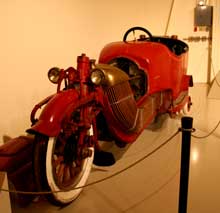Slips Loose
James Scripps Booth was an accomplished artist, though largely self-taught since he dropped out of prep school after tenth grade. The son of newspaper publisher George Gough Booth and newspaper heiress Ellen Scripps, James was also enamored of automobiles, so much so that he resolved to invent his own. Drawing his contraption in 1908, he was able to make it a reality in 1912, the Bi-Autogo, a three-seat motorcycle with training wheels, powered by a massive V8 engine. Only one was built, as the vehicle was nigh unmanageable.
Retreating to the other end of the automobile scale, James signed on to the cyclecar craze that swept the United States in 1914. Started with the Bédélia in France, the movement touted light, economical transportation for two, usually tandem seating with motorcycle power. Cyclecars had the virtue that one didn't need a garage, nor a driveway. James's Scripps-Booth Rocket, powered by a V-twin Spacke engine and driven with a long belt (missing in this view), was in tune with the cyclecar idiom, and was gone just as quickly, since by 1915 a Model T Ford, a real car, sold for just $440, less than the price of most cyclecars.
Then James decided to build a real car of his own. He hired William B. Stout, later to build an all-metal airplane in the 1920s that led to the Ford Trimotor and his own radical Stout Scarab in 1935, to design it. The Scripps-Booth Model C, a jaunty little runabout with a stylish German silver radiator, Houk wire wheels and powered by a Sterling four-cylinder engine, arrived in February 1915. Initially the cars were troublesome, earning the nicknames "Scraps-bolts" and "Slips-Loose," the latter perhaps a malady of all belt-drive vehicles and a hang-over from Rocket days. Eventually the bugs were worked out, but fully one third of production seems to have gone overseas. James the artist did all the advertising illustrations, helping to move, by accounts, some 6,000 cars by 1916. A V8 model appeared that year, but James disliked the implicit retreat from the light car idiom, nor did he care for the change to a Chevrolet 490 engine that summer. Fed up, he resigned in October, after which the company was sold to Billy Durant, who was in the process of taking back General Motors with the trojan horse of Chevrolet. Within a short time the Scripps-Booth was a faceless and unwanted GM marque with Northway engine in an Oakland chassis. It was euthanized in 1922.
James, however, was not through with automobiles. He designed another light car, the low-riding DaVinci, but was unable to interest anyone in producing it. When Stutz introduced the low-slung Safety Stutz in 1926, James sued, claiming that Stutz's Fred Moscovics had stolen his design. Eventually, in 1935, James won, but all his award money went for legal fees. By then he had already returned to the cyclecar idea, with the DaVinci Pup, a tandem-seat, driver-aft car with belt drive, but the market held no demand for such a vehicle. Ironically, belt-drive of a sort has finally hit the mainstream with continuously-variable transmissions.
The solitary Bi-Autogo survives, owned by the Detroit Historical Society but now on loan to the Owls Head Transportation Museum in picturesque Owls Head, Maine. Owls Head also has a Rocket cyclecar belonging to Detroit Historical, as well as a Model C roadster of its own. The DaVinci Pup was given by James to Detroit Historical, where it remains in storage. The only DaVinci car was given by James's widow to Northwood University in Michigan, but has since been sold to a private collector. An active Scripps-Booth Register tends to the needs of surviving cars and their owners. Now and then, you can find Scripps-Booth cars at Hershey.

